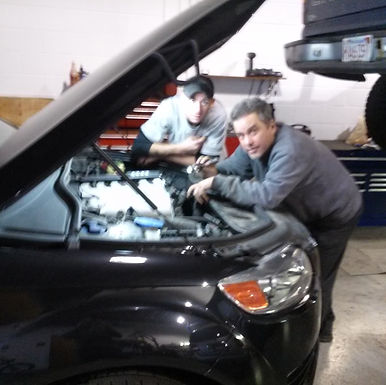
Engine Diagnosis and Repair
Engine repairs at The Driveway Doctors always start with troubleshooting and diagnostics. Repair recommendations are then made by our experienced, ASE-certified technicians. This helps us better target the problem and improves our repair efficiency.
Tracking Down the Causes of Engine Failure
You have to figure out why the engine failed so the repaired engine will not suffer the same fate. A good place to start is to review the circumstances that preceded the failure. Sometimes failures occur unexpectedly. In most instances though, there is ample warning that something is amiss - long before the engine actually fails.

Unusual engine noises, low oil pressure, engine overheating, loss of power, misfiring, hard starting and similar drivability- and performance complaints can all be indications of problems that need attention. The cause may be something minor or major. There is no way to know unless somebody checks it out. If the motorist ignores such warnings long enough, it can be a very costly mistake because eventually the engine will give in to whatever is causing the problem.
Causes of Engine Failure:
The major causes of engine failures can be lumped into four basic categories: Overheating (excessive heat) ; Lack of Lubrication Detonation (Spark Knock) ; Wrong Assembly (Misassembly)
Engine Overheating -
Overheating can be caused by any number of things. It is often the result of coolant loss or a low coolant level, which may be due to leaks - in the hoses, the radiator, or the engine itself. A weak radiator cap that leaks pressure can allow coolant to escape from the system. Not getting the cooling system completely filled, after changing the antifreeze can allow steam pockets to form that make the engine overheat or run hot. An electric cooling fan that fails to come on due to a faulty thermostat, relay, wiring or motor may be an overlooked cause of overheating. So too can a slipping fan clutch. Even a missing fan shroud that reduces the fan's effectiveness may be a contributing factor. Another common cause of overheating is a faulty thermostat. When most thermostats fail, they prevent the flow of coolant from the engine to the radiator. Replacing the thermostat will solve the problem, but it may not prevent the same thing from happening again. It is best to install a "fail-safe" type of thermostat that still allows some coolant flow, in the event of failure in the future.
Less obvious causes of overheating can include a clogged radiator that is filled with sediment - as a result of coolant neglect, corrosion or, using excessively hard water. Incorrect ignition timing and a lean fuel mixture (due to air leaks or low fuel pressure) can also elevate normal operating temperatures. An exhaust restriction (clogged catalytic converter) can also make the engine work harder causing it to run hot. Too much heat in an engine can cause serious problems because heat causes metal to expand. Excessive heat can cause cylinder heads to swell, warp or crack. Aluminum heads are especially vulnerable to warping and cracking. In engines where the center exhaust ports are joined together, hot spots can cause the head to swell and crush the head gasket, resulting in a blown head gasket. Replacing the head gasket may temporarily solve the compression problem, but unless the underlying cause of the elevated temperature is diagnosed and corrected, the replacement gasket may eventually suffer the same fate. Engine
Failure Caused by Lubrication Problems -
Every engine needs motor oil between its moving parts not only to reduce friction but also to carry away heat. Oil is the primary means the rod, the pistons, and main bearings are cooled. Any reduction in oil flow may cause these parts to run hot, gall and seize. Low oil pressure is often a contributing factor in an engine failure. The cause may be a worn oil pump or excessive clearance in the main and rod bearings as a result of high-mileage wear or neglect of not changing the oil and filter often enough.
Oil starvation is always fatal to any engine, and usually the result of a failed oil pump, a plugged oil pickup screen inside the oil pan, or a low oil level. Damaged bearings as a result of insufficient lubrication will be shiny and worn where the crankshaft journal has wiped away the bearing material. Overhead cam engines are more vulnerable to oil starvation and low oil pressure problems than pushrod engines because the cam and valve train are farther from the pump. When an OHC engine is first started, it takes a while for oil pressure to reach the cam bearings. If the oil viscosity is too heavy (especially during cold weather), it delays the arrival of oil long enough to starve and seize the cam. Refilling the crankcase with the recommended viscosity oil can prevent a reoccurrence of this failure. Check the dipstick to see how much oil is in the pan. A low oil level may be the result of neglect, oil leakage or oil burning.
Oil-fouled spark plugs and a heavy buildup of black wet deposits on the back of the intake valves and in combustion chambers would tell that the engine had been using oil. Oil usually enters the combustion chamber past worn valve guides and seals, and also past worn or broken piston rings and worn cylinders. Worn valve guides can sometimes be knurled to reduce clearances, but it requires installing new guides, guide liners or valves with oversized stems. Installing new valve guide seals can reduce oil burning dramatically. An engine that sucks a quart of oil every few hundred miles may be able to go several thousand miles without using any oil with a new set of valve guide seals. Any evidence of oil leakage around the front or rear crankshaft seal, pan gasket, valve cover gasket or other gaskets, would tell you that new gaskets and seals are needed. Most of these gaskets and seals will have to be replaced anyway if you are opening up the engine. Bearings ruined by dirty oil will have foreign material embedded in the surface and be scored by debris. Check for a plugged oil filter, a missing air filter, oil filler or breather cap. The underlying cause may be not changing the oil often enough.
Engine Failure Caused by Detonation -
Detonation (Spark Knock) is a form of abnormal combustion that results from too much heat and pressure in the combustion chamber. The fuel ignites spontaneously causing a sudden rise in cylinder pressure. The result is a sharp blow on the piston that produces a metallic knocking or pinging noise.
Light detonation is considered normal and should not cause any damage, but heavy or prolonged detonation can crack rings, pound out piston ring grooves, punch holes through the tops of pistons, smash rod bearings and blow head gaskets. Pre-ignition occurs when a hot spot inside the combustion chamber ignites the fuel before the spark does. The hot spot may be an overheated exhaust valve, a spark plug that is too hot or even a sharp edge in the combustion chamber itself. Such hot spots can be caused by anything that makes the engine run hotter than normal or inhibits normal cooling (such as a buildup of carbon deposits). A hot exhaust valve may be the result of insufficient valve lash, a weak valve spring, excessive wear of the valve stem or guide, or retarded ignition timing. Pre-ignition can be a contributing factor in detonation.
Detonation can have numerous causes. One of the most common ones is loss of EGR. The Exhaust Gas Recirculation system dilutes the air/fuel mixture. Anytime you find evidence of detonation damage, be sure to check the EGR valve and system. Other causes of detonation include excessive compression, elevated engine operating temperature, pre-ignition, over advanced ignition timing (spark knock), lean fuel mixture, spark plugs that have too hot a heat range for the application, low octane fuel, and even bad driving habits such as lugging the engine excessively with a manual transmission. If you find detonation damage in an engine and heavy accumulation of deposits in the combustion chamber, this is the result of a rich fuel mixture and oil burning. Frequent short trip driving also accelerates deposit formation. Black, oily deposits in the combustion chambers and on the backs of the intake valves point to worn valve guides and seals as the cause. Black dry carbon deposits should lead you to check for conditions causing the fuel mixture to run rich (a bad oxygen sensor, a defective coolant sensor that keeps the computer in open loop, or excessive fuel pressure in a fuel injected engine). Detonation may also be a problem if someone has done a performance tune on the engine computer and gotten the spark timing over advanced and the fuel mixture too lean. Either condition may result in detonation when the engine is under heavy load or accelerating hard. Note that a performance tune may void the vehicle power train warranty.
Engine Failure Due to Wrong Assembly -
You may ignore wrong assembly as a factor in a high mileage engine failure. But in a newly-rebuilt engine or a low mileage failure, it should be considered as a possibility.
Some common mistakes to look out for:
Incorrect engine bearing clearances (too tight or too loose)
Galling or seizure would tell you bearing clearances were too tight, while fatigue failure would point to excessive clearances.
Insufficient Valve-to-Piston Clearance/Piston-to-Cylinder Clearance
Not checking clearances may result in valves hitting pistons (especially with high lift cams or rocker arms), or pistons sticking in cylinders. Incorrect torque on critical fasteners like head bolts, rod and main bearing cap bolts. Head bolts should be lightly lubricated with 30W engine coil prior to installation and then torque in the proper sequence to the vehicle manufacturer specifications. Too much torque can crush the head gasket while too little torque or uneven torque can lead to leaks. Too much torque on rod and main bearing cap bolts may crush or deform bearings, or cause the bolts to fail.
Misalignment
If the center main bearings show greater wear than the end bearings, the crankshaft may be bent or the main bores may be misaligned. The condition must be corrected by straightening or replacing the crank and align boring the block. The same applies to camshafts and cam bearings.
Failure to clean parts properly during engine assembly (not scrubbing out the cylinder bores with soap and water to remove debris and honing residue after they have been bored or honed, as examples) - Any junk that is left in the engine can scour bearings and wear surfaces.
Failure to lubricate parts properly during engine assembly
Camshaft lobes require a high pressure engine assembly lube that will stay put until the engine is started and until the oil reaches the cam.




